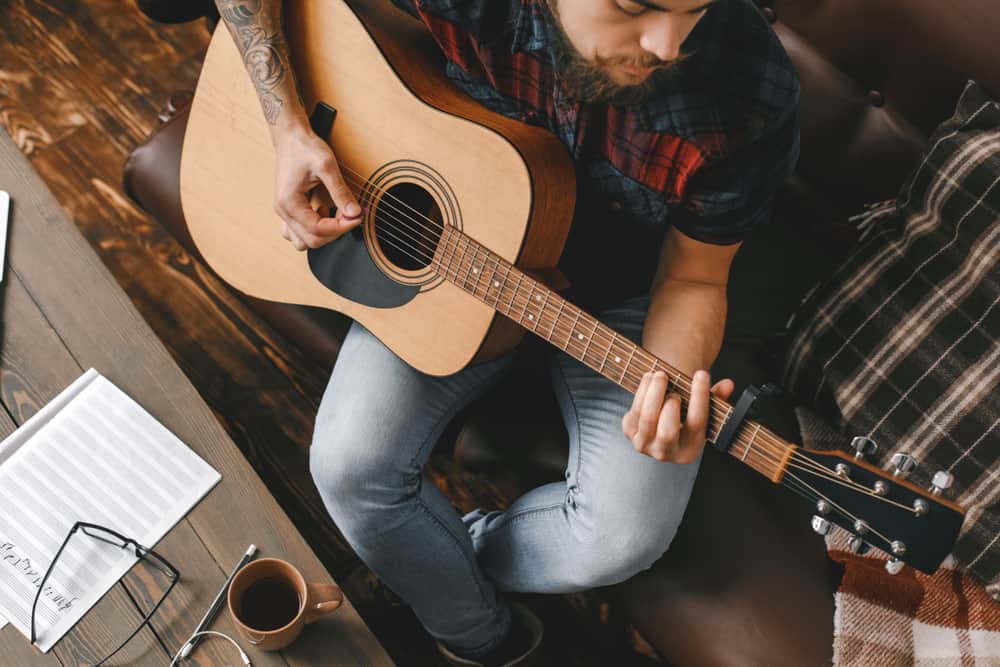Welcome, fellow musical wizards and apprentices, to the enchanting world of guitar composition! Like a sorcerer summoning melodies from thin air, crafting musical magic on the guitar requires skill, creativity, and maybe a sprinkle of pixie dust. In this guide, we’ll delve into the essential ingredients needed to concoct captivating compositions that will have listeners spellbound. So grab your guitar wands and let’s brew up some musical mojo together!
Contents
- 1 Understanding the Fundamentals of Guitar Composition
- 2 Exploring Chord Progressions and Melodic Structures
- 3 Incorporating Rhythm and Groove into Your Compositions
- 4
- 5 Experimenting with Advanced Guitar Techniques
- 6 Crafting Your Unique Sound through Tone and Texture
- 7 Navigating the World of Recording and Production for Guitarists
- 8 FAQs
- 9 Rock On and Keep Crafting!
Understanding the Fundamentals of Guitar Composition
So, you’ve picked up the guitar and now you’re ready to dive into the world of composition. But where do you start? Fear not, my friend! Let’s break down the fundamentals of guitar composition in a way that’s easy to understand (and hopefully a little entertaining).
First things first, let’s talk about chords. Chords are like the building blocks of a song, providing the harmonic foundation for your composition. Learn a few basic chords like G, C, D, and Em, and you’ll be well on your way to creating your own unique sound.
Next up, we have riffs. Riffs are those catchy little melodies that often serve as the main hook of a song. Experiment with different scales and patterns to come up with riffs that will make your audience want to headbang along.
And let’s not forget about song structure. A typical song structure consists of verses, choruses, bridges, and maybe even a guitar solo if you’re feeling fancy. Mix and match these sections to create a dynamic and engaging composition that will keep your listeners on their toes.
Exploring Chord Progressions and Melodic Structures
So, you’ve decided to dive headfirst into the oh-so-mysterious world of chord progressions and melodic structures. Well, buckle up, my friend, because you’re in for a wild ride!
First things first, let’s talk about chord progressions. These bad boys are like the building blocks of any good song. They’re the magical sequences of chords that make your heart soar and your toes tap. And hey, there are no rules here! Mix and match, switch it up, make it your own. You’re the captain of this musical ship!
Now, onto melodic structures. This is where the REAL fun begins. Melodies are like a secret language, speaking directly to your soul. They can be sweet, sassy, haunting, or downright funky. It’s all about finding that perfect balance between tension and release, creating a musical journey that takes your listeners on a rollercoaster of emotions.
So, grab your instrument of choice, let your imagination run wild, and get ready to blow your audience’s minds with your killer chord progressions and mind-blowing melodic structures. The world is your musical oyster, my friend!

Incorporating Rhythm and Groove into Your Compositions
When it comes to injecting rhythm and groove into your compositions, think of it as adding the secret ingredient that takes your music to the next level. It’s like sprinkling a little bit of magic fairy dust on top of your already awesome creation – it just makes everything come alive!
Here are some tips and tricks to help you master the art of incorporating rhythm and groove into your music:
- Experiment with different time signatures: Don’t be afraid to step outside of the traditional 4/4 time signature. Try experimenting with 6/8, 7/8, or even 5/4 to create interesting and unique rhythmic patterns.
- Layer different percussion elements: Mix it up by adding a variety of percussion instruments like shakers, tambourines, or hand drums to create dynamic and complex grooves.
- Play with syncopation: Spice up your melodies by adding unexpected accents or off-beat rhythms to keep your listeners on their toes.
Remember, rhythm and groove are what make people want to tap their feet, nod their heads, and get up and dance. So don’t be afraid to experiment, push the boundaries, and most importantly, have fun with it!

dynamics-and-expression-in-guitar-music”>The Role of Dynamics and Expression in Guitar Music
When it comes to playing the guitar, dynamics and expression play a crucial role in bringing the music to life. Without these elements, guitar music would be as exciting as watching paint dry on a rainy day.
Imagine listening to a guitar solo that is played with the same level of volume and intensity throughout. It would be like eating a sandwich with nothing but plain bread – boring and uninspiring. Adding dynamics allows the music to ebb and flow, creating tension and release that keeps the listener on the edge of their seat.
Expression is like the icing on the cake of guitar music. It’s what gives the music personality and emotion. Without expression, a guitar solo would sound as robotic as a malfunctioning vending machine. By bending notes, adding vibrato, and using techniques like hammer-ons and pull-offs, a guitarist can infuse their playing with soul and feeling.
So, next time you pick up your guitar, remember the importance of dynamics and expression. Play with feeling, experiment with different levels of volume and intensity, and don’t be afraid to let your emotions shine through your playing. Your audience will thank you for it!

Experimenting with Advanced Guitar Techniques
So, you’ve mastered the basic chords and can strum along to your favorite tunes – congrats! But now, it’s time to take your guitar playing to the next level by experimenting with some advanced techniques. Get ready to impress your friends and wow your audience with these cool tricks.
First up, let’s talk about sweep picking. This flashy technique involves using a pick to play rapid arpeggios across multiple strings. It may sound daunting at first, but with practice and patience, you’ll soon be shredding like a pro. Start slow and gradually increase your speed – before you know it, you’ll be sweeping effortlessly across the fretboard.
Next, why not try your hand at tapping? Made famous by guitar virtuosos like Eddie Van Halen, tapping involves using your fingers to tap out notes on the fretboard, creating a fast and dynamic sound. Experiment with different rhythms and patterns to create your own unique tapping style – who knows, you might just discover the next big guitar trend!
And finally, don’t forget about hybrid picking. This technique combines both pick and fingers to achieve a versatile and nuanced sound. Use your pick for power chords and strumming, while using your fingers to pluck out melodic lines – the possibilities are endless. So grab your guitar, roll up your sleeves, and get ready to take your playing to new heights with these advanced techniques.
Crafting Your Unique Sound through Tone and Texture
When it comes to crafting your unique sound, tone and texture are key elements to consider. With the right combination of these factors, you can create music that is truly one-of-a-kind. To help you along your journey, here are some tips and tricks to make your music stand out from the crowd:
First and foremost, experiment with different types of instruments and equipment. Whether it’s a vintage synth or a funky guitar pedal, don’t be afraid to try new things and see what works best for you. You never know what kind of sounds you might discover!
Next, don’t be afraid to play around with effects and plugins. From reverb to distortion, adding a touch of effects can really enhance the tone and texture of your music. Try layering different effects together to create a rich and dynamic sound that’s all your own.
Lastly, don’t forget to trust your instincts and follow your gut. Music is meant to be a reflection of your personality and creativity, so don’t be afraid to let loose and have fun with it. Remember, the more you play around with tone and texture, the more likely you are to stumble upon something truly unique and special.
So, you’ve decided to dive into the wild world of recording and production as a guitarist. Congratulations! Get ready for a rollercoaster of emotions, from elation to frustration and everything in between. But fear not, brave soul, for I am here to guide you through this treacherous journey.
First things first, you’ll need to invest in some essential gear. Think of it as your superhero utility belt, but instead of grappling hooks and batarangs, you’ll be packing things like an audio interface, a good set of studio headphones, and of course, your trusty guitar. Remember, a guitarist is only as good as his tools, so don’t skimp on quality!
Next, familiarize yourself with the digital audio workstation (DAW) of your choice. Whether you’re a Pro Tools pro or a GarageBand newbie, mastering your DAW is crucial for crafting killer guitar tracks. Experiment with different effects and plugins to find your signature sound, and don’t be afraid to think outside the box – after all, rules are meant to be broken!
Lastly, don’t be afraid to seek help when you need it. Whether it’s a YouTube tutorial, a fellow guitarist, or even a professional producer, there’s no shame in asking for guidance. Remember, even rock gods like Jimi Hendrix and Eric Clapton had to start somewhere. So strap in, dear guitarist, and get ready to conquer the world of recording and production – one epic riff at a time!
FAQs
What is the most important thing to consider when composing a guitar piece?
Well first off, make sure your guitar is actually in tune. No one wants to hear a beautiful composition played out of key!
How can I add color and texture to my guitar compositions?
Think of your guitar as a canvas and experiment with different techniques like fingerpicking, slides, and hammer-ons to add some artistic flair to your music. Don’t be afraid to get a little wild!
What are some common pitfalls to avoid when composing for guitar?
Avoid getting stuck in a boring chord progression rut. Spice things up by throwing in unexpected twists and turns to keep your listeners on their toes. And for the love of music, please don’t overuse the dreaded G-C-D progression!
How can I develop my own personal style as a guitar composer?
Listen to a wide range of music genres and dissect what you love about each one. Then, take those influences and mash them up into something uniquely you. Who knows, maybe your signature sound will be a mix of classical, punk rock, and polka!
Is there a secret formula for crafting musical magic on the guitar?
Yes, the secret formula is… there is no secret formula! The key to creating truly magical music is to let your creativity run wild, break all the rules, and most importantly, have fun with it. So go forth and compose your masterpiece, you musical wizard, you!
Rock On and Keep Crafting!
Congratulations, you’ve now unlocked the secrets to crafting musical magic with guitar composition essentials! Now, go forth and rock out with your guitar in hand, channeling your inner musical genius to create the next chart-topping hit. Remember, practice makes perfect, so keep strumming those chords and experimenting with new melodies. Before you know it, you’ll be a guitar composition master, enchanting audiences with your musical prowess. Keep strumming, keep crafting, and keep rocking on!



